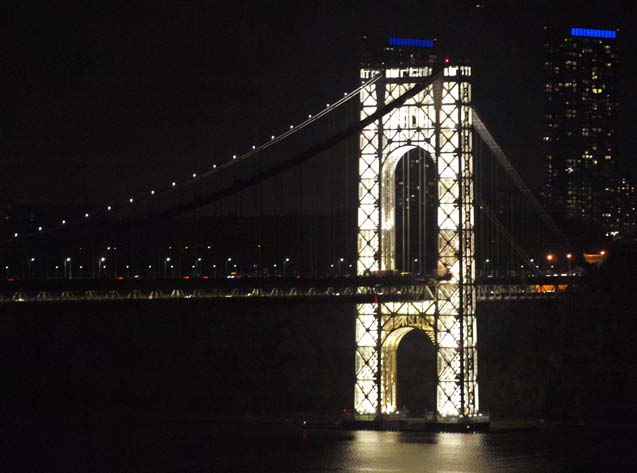Peter Weinberger
Hudson Heights Impressions
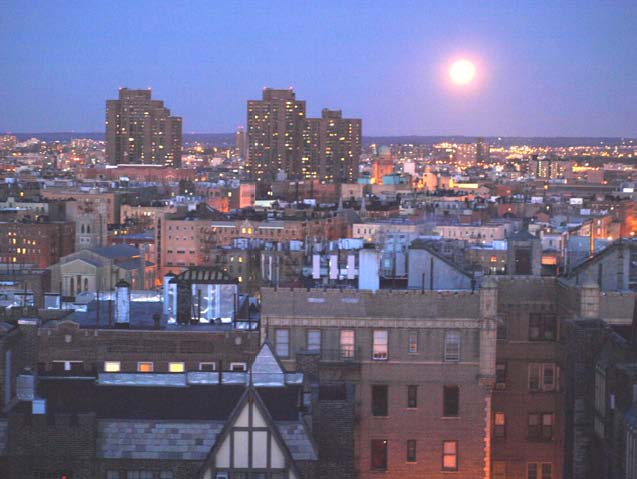
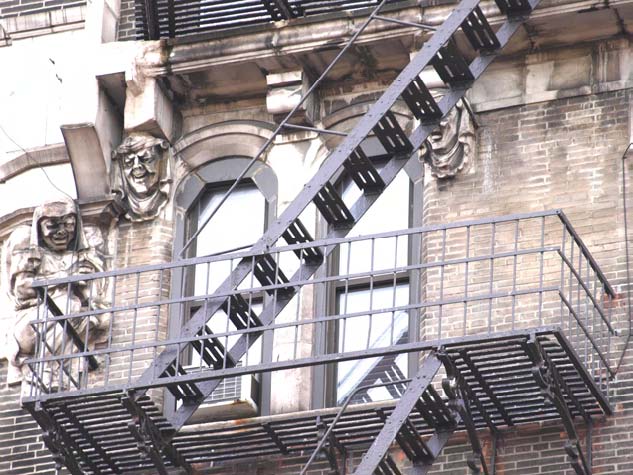
© Peter Weinberger, Wien/New York 2019-20
Introduction
Officially the term „Hudson Heights“ refers to an area in Manhattan confined by the 173rd Street in the south, the Fort Tryon Park in the north, the Henry Hudson Parkway to the west and the Broadway. Of course, political boundaries become meaningless once it comes to define a cultural entity as all neighboring areas contribute to a local identity.
The soft edge in direction St. Nicholas, a part of the Latino barrio sometimes termed „Dominican Republic“, contributes to that identity as much as the „charm“ of Fort Tryon Park, sections of Inwood and — of course — the view of and entrance to the George Washington bridge, short GW Bridge, as the most outstanding site in the Hudson Heights.
While political boundaries simply refer to a certain contour on a map, a characterization of a cultural identity is much less easy to give, if not impossible altogether.
In the present case, it needs to walk around in the Heights and neighboring bits, look at buildings, houses, watch people moving, talking, laughing, hear parts of the local gossip and observe persistent peculiarities concerning its inhabitants and places in which they live.
Part of this identity is determined by religious identifications, since the Heights does have a considerable Jewish population, but, all the other denominations — from Zwingli-related Evangelicals to Catholics also contribute.
All that, plus inherent features of public (local) traffic, a kind of „ambiente“ of an area, have to be taken into account.
And there is the historical background as the Heights used to be one of the preferred places in New York City for all those that succeeded to escape Nazi-Europe, followed later on by a slow moving in of predominantly Spanish speaking minorities.
Actually, even the term „minorities“ became meaningless in New York, because there are so many of them: one is almost tempted to say the city itself is a kind of „minority“ within the United States.
The colloquial language spoken reflects past and present minorities as well as social status and self-esteem at the same time. It can sound polite or rude, like any other „living“ language. Hudson Heights is not a silk stockings area.
To grasp the cultural identity in the Heights at least partially, perhaps the best way is to use a literary form, to compile very short stories in the manner of „written“ photographs.
There is no particuar order in the sequence of these stories, besides viewing Hudson Heights from south to north. Some of them will be amusing to read, some might sound a bit too serious, quite a few are augmented by photographs, all of them gathered by walking around in the Heights.
[1] The MTA guys
From the entrance to the 181st Street subway station on Fort Washington Avenue just across Bennett Park, three slightly antique, matchingly shabby elevators lead down to the level of the station master and an exit to Overlook Terrace. During working hours as a kind of special service to the public, and obviously caring for security, one of the elevators is operated by an MTA(1) employee.
In the corner of that elevator, directly in front of the level buttons, there is a very small table together with an old office chair, a 4ft high paravent and in winter a tiny electric heater. The table is worn out, the paravent carries duck tape „band aides“ that prevent it from falling into pieces.
Some of the operators seem to be retired MTA staff members, however, occasionally also younger persons are on guard. All of them wear black MTA outfits and heavy boots. Apparently, they know already most of the people that use the elevators during the morning or evening rush hours.
One of them, a slightly obese guy, is extremely friendly, talks to everybody and addresses all the kids walking in. He greets politely his customers and wishes them „a nice day“ when they leave. This he repeats, many times, going up and going down, he never seems to be bored by his job.
Another one, an elderly man with a grey goatee and curly hair operates the elevator like the pilot of a Jumbo jet. Greetings he replies with a gracious nodding of his head. In order to avoid using his fingers to press the buttons he has a kind of rod made from an appropriately folded newspaper and held together by rubber bands. Any thanks offered by his customers are acknowledged nodding again his head.
Usually the MTA guys have a local newspaper lying on the little table in front of them, rereading the same advertisments many times, or, at least pretending to read.
The one with the goatee occasionally puts up a little radio and listens to a Jazz channel: the elevator turns into an enjoyable ride into the just started day or helps to tune off from job worries.
Clearly, most of the operators speak automatically Spanish to everybody, since the station, at least the lower part of it, is already part of the „Dominican Republic“, as this part of New York is usually called.
One easily gets used to the local habits in the Heights. Its an area of plain people, not used to wear three piece suits.
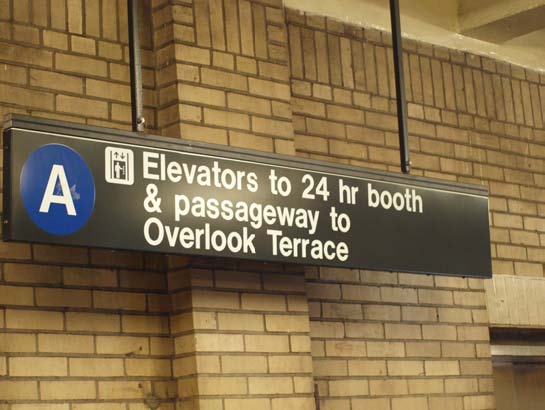
181st Street under ground station, Bennett Park entrance
[2] The 190th underground station
Like a medievial fortification the castle hill area is equiped with (rescue or escape) tunnels. The one, which is part of the 190tht Street station of the A-line does indeed deserve to be called a secrete path through the underworld as it connects two very different parts of the city. Almost like in the movie „The Lord of the Rings(2)“, in which hidden gates to the empire of the dwarfs are impressively shown, its entrance on Bennett Avenue is carved into a steep rock. Contrary to the movie, however, no mysterious riddles have to be solved in order to open its heavy wooden doors.
Coming from Broadway, once being inside the tunnel, at first is seems having entered an underground mine in which surely precious minerals are scraped off the solid rock. Only after having passed the first half of the tunnel the office of the station master comes in sight and the electric entrance machines to the tracks are visible. As is „canonical“ for most other stations, to get down there a staircase has to be mastered. Although nowadays used in a different context, the word „grotesque“ in its original meaning, namely referring to the Italian word for a cave („grotta“), describes perhaps best the area of the tracks.
Most important for quite a few locals are the elevators that connect the underworld to a plattform from which the castle hill area can be reached via a staircase. It does not have to be stressed that these elevators are of the same charm as those at the previous station: antique, shabby, but with a camouflage of colorful MTA-related posters. The plattform itself is meant as a kind of concrete playground, since volley ball nets are waiting to be used. Also a few, only occasionally used benches are put up.
Finally, after having climbed the last staircase up to Fort Washington Avenue, one suddenly becomes aware of the fact that actually a vast area mainly occupied by an oversized round-about has been reached.
The impression of having entered a fortified castle is immediately magnified there by the style of the top part of the subway station. Like a medievial watch tower it is constructed from bolder-like solid rock bricks with no obvious entrance at the level of the street. Since three blind „gothic“ window arches are part of its northern wall, one might even think of an ancient castle chapel.
There is one thing one has to remember when using the tunnel of the 190th Street station. Walking from Broadway up to the mysterious gate on Bennett Avenue the street is quite steep: like an easily defendable ramp that separates the lower bits of Fort Tryon Park from the most northern parts of Hudson Heights.
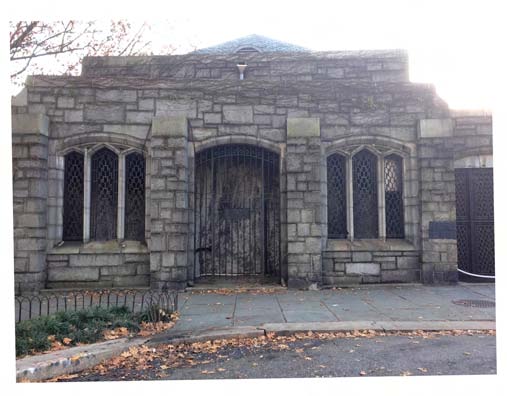
The top part of the 190th Street underground station
[3] Jesus, the Saviour
Whenever I pass that busy corner of Wadsworth Avenue and 181st Street on my way to the Latino fish monger, there is an elderly man trying desperately to convince those waiting for the traffic light to turn green of the virtue in believing in Jesus, the Saviour. He is there independent of the weather conditions and waits patiently for someone finally to be interested in his brochures.
I have no idea to which denomination he belongs, there are so many of different kinds in this neighborhood. Should I talk to him? Should I ask him, why he thinks Jesus is the Saviour of the world? Or only of the country? Or just of the barrio? Should I inquire whether he actually knows anything about the history of Christianity in this part of the world? Of the differences of his church with all the other churches nearby? Of the political role his church plays in this country? Probably it is not worth the effort, he quite likely would not understand my questions at all, since -at least for him -the truth is so obvious.
After having bought my two pieces of blue snapper and having listened shortly to the gossip in the eating corner of the fish place, I usually assure myself that he is still standing there with his pamphlets and pictures that refer to the kitschy taste of the early 19th century. How come, I ask myself, that these pictures, meant to be distributed to the uninitiated, seem to be independent of time and geography?
I feel a little sorry for him. Despite the fact that hundreds of people pass by nobody, absolutely nobody shows any interest in him or in his carefully arranged and displayed exhibits.
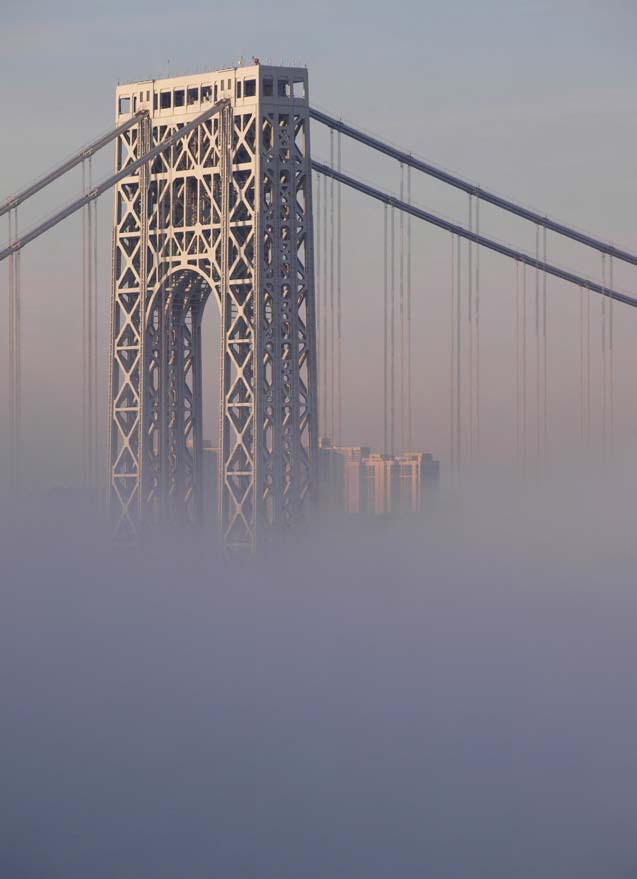
George Washington Bridge in fog
[4] The girl with the earrings
In the local supermarket, located close to the steep staircase that leads from the Overlook Terrace to Fort Washington Avenue, all the young women at the cash register are of Hispanic origin. If no or only a very few customers are present, they chatter and laugh happily across all counters.
Most of the girls there are from the local barrio and fit pretty well in the overall appearance of young females in Washington Heights: they are a little plump and seem to meet perfectly Hispanic aesthetics concerning round bottoms.
However, occasionally there is one girl, a tiny, slim person with a lovely face of dark brown complexion and long black hair. She must have been hired straight after having finished school as she appears to be very young indeed. The most striking part of her appearance are the large, ring-like earrings she wears.
Despite her staggering beauty she most likely is teased permanently by her colleagues for being too skinny to attract the interests of young men. Perhaps she wears these earrings only as an eye catcher to overcome her „deficiency“ of not having a backside of canonical shape. She ambitiously handles all the shopping put on the conveyor belt, rarely looking up to the customer she just serves. It’s only a few moments her beautiful black eyes can be seen.
There is little doubt that very soon she will be pressed back into the routine life of the barrio, having children of her own and the usual worries about paying open bills and managing daily life disappointments.
I fear her time at a counter in the supermarket might turn out to be the only happy, unconcerned period in her life, a period, full of expectations in the future that just started and that she welcomed with the earrings she proudly wears as a proof of being grown up.
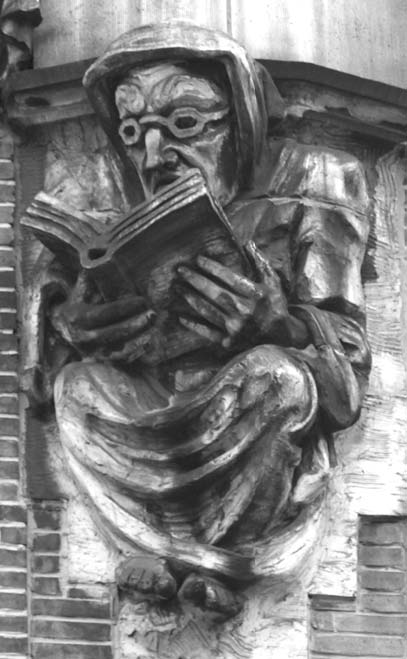
The house with gargoyles, corner of Fort Washington Avenue and 181st Street
[5] Dan’s supermarket
Have you ever been in Dan’s supermarket at the corner of St. Nicholas Ave and 185th street? If not, then you really missed genuine „Hispano“-daily life culture. Most striking there: the monument-like piles of tins along the backwall of the shop that reach almost up to the ceiling. There is, for example, a refried beans monument, or, a pile composed of canned black beans. These monuments cannot be missed as they are immediately behind a huge column of Cafe Bustelo tins, packed bright yellow.
Right at the entrance vegetables and fruit are displayed. Don’t forget to buy a few platanos(3) even if you don’t know what to do with them. They look like bananas but are only meant for cooking.
Well, and then before you hit the butcher’s corner with enormous heaps of large steaks of all kinds, you pass by the cheese department. There it is your chance to get a few cheeses from Mexico, for example from Oaxaca, or string cheese from Honduras. Of course all the other typical American „processed cheeses“ are also on display, but not really worthwhile to look at as they can be bought in almost every grocery store or so-called delicatessen.
Much more intriguing is the pile of bacalao salado(4), namely of dried and salted cod that usually does not enter typical American cuisine. You can find there also a box of dried, smoked and salted herring, inviting again to enter experimental cooking.
In the remaining corridors you probably will be surprised about the huge bags of rice or other dried food, meant for the use in big families. Of course one can pick up also the regular sized packages, but they are less impressive.
Finally, indeed amazing are the overfull shopping carts usually women drive to the check out, at which only Spanish is spoken. The amout of food purchased at Dan’s supermarket is staggering. At least there, at the counters, you suddenly realize that you are probably the only non-Hispanic in this shop.
Outside of the shop a few men hang around prepared to wheel back home the overloaded carts for a few dollars. Most of the time, however, they just chatter and comment on everybody passing by, predominantely of course remarks are made concerning young females. To chatter without rush, without being pressed by obligations arising from daily live needs seems to be part of the pleasures the barrio garantuees. For everything else their wives are responsible.
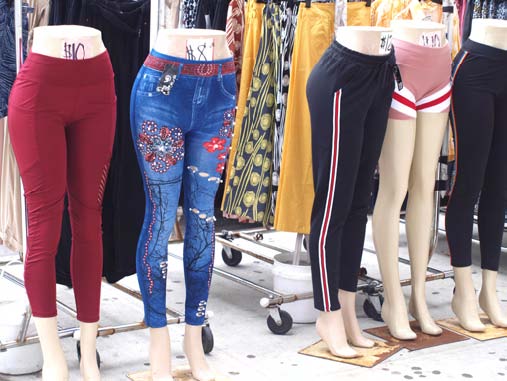
[6] Yet another grocery store
Speaking of grocery stores, there is yet another one on St. Nicholas that is worthwhile to visit not only because most vegetables displayed there are indeed very cheap, but also because of the two young women that stand behind the counter. Both wear gloves, put bags of potatoes or cabbage heads on the balance attached to a cash desk, type in the price, hand out the return money and: NEXT! Needless to say that nearly everybody pays in cash.
It is an almost machine-like procedure, completely automatized. Only occasionally a short communication with a cunstomer is to be heard. The noise coming in from the street, intensified by the chattering of those waiting in line, is only interrupted by their loud NEXT!
The shop itself is a bit shabby, however, not shabbier than other shops of this kind on St. Nicholas. The two women don’t seem to be bored by their job, lasting probably many hours per day, bored by the endless lifting of vegetables on a balance.
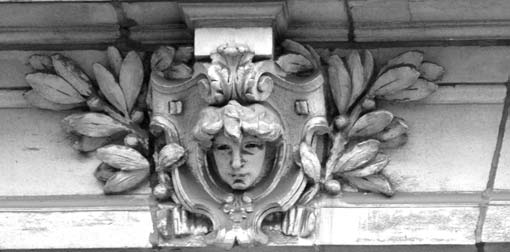
A typical eave decoration on Fort Washington Avenue
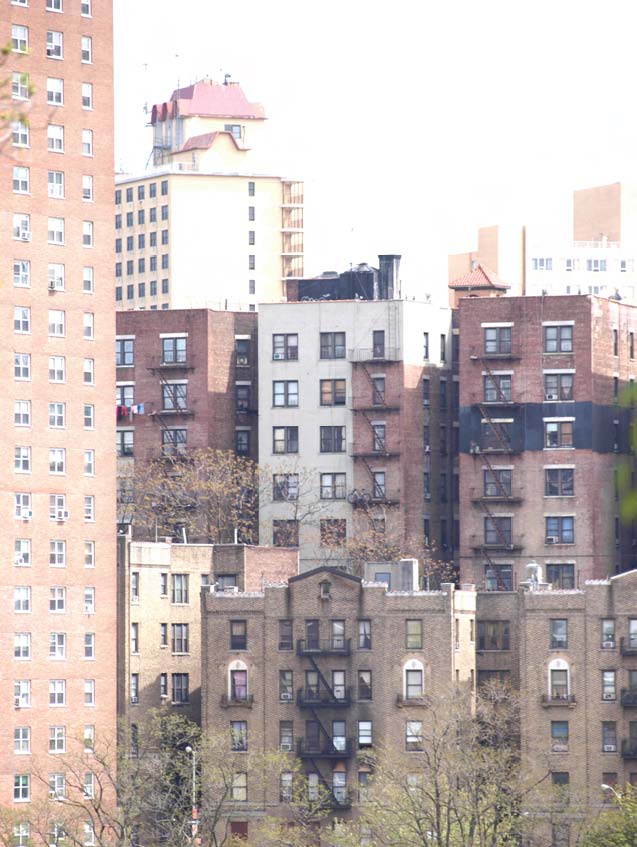
Hudson Heights backyards
[7] The Latino fishmonger
Did you know that there is a whole family of fish called snapper? Besides the probably well-known red snapper, there is a blue-and-gold variety and black-and-white snappers. Even the term red snapper can occasionally be misleading, since Tilapia is sometimes wrongly sold as red snapper or served as such in sushi restaurants.
In the Mid Atlantic Fish Market near the south-east corner of Broadway and 181st Street, an impressive choice of fresh fish, neatly cut up into slices and resting on a bed of ice cubes, is on display. Besides red and blue snapper usually cod, monkfish, tuna, tilefish and catfish are waiting for customers. And of course fresh shrimps of various sizes and other sea food.
Entering the shop there are two counters: one offering fresh fish and sea food and opposite to it the ready-to-eat stand. Although for ordering English can in principle be used, nearly everything else seems to be „Latino“: even seen from the street side advertisments for sopa de marisco and pescado al vapor are an indication for a „Latino“ fish monger.
Behind the fresh fish counter, separated by a small corridor, one can see a bench, where bigger fish are sliced up. Because everything is watery and wet the shop attendants wear rubber boots that seem to be several sizes too large for them. For hygenic purposes bought pieces of fish are first put into a plastic bag, then in a brown paper bag and finally again in a black plastic bag.
If you intend to go there, don’t try to visit the place as part of an early morning shopping tour. They open rather late in the morning, even ten o’clock is a kind of imaginary number in wishful thinking. Before you leave, don’t forget to take an empanada filled with shrimps along. These empanadas, slightly spicy, are delicious!
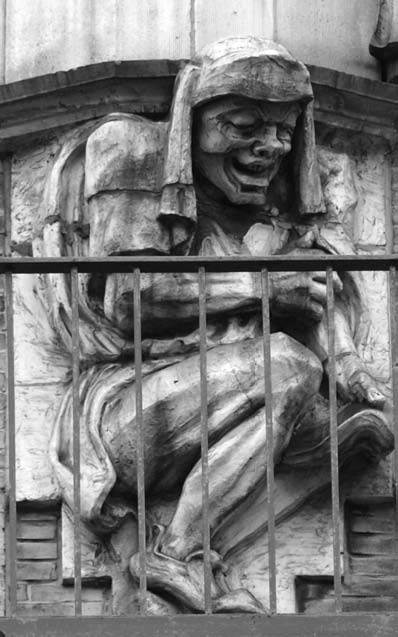
House with gargoyles, corner of Fort Washington Avenue and 181st Street
[8] Botero and the furniture shops
Everytime I walk by one of those overloaded furniture shops on St. Nicholas or on the 181st Street I fancy seeing Botero(5) paintings in front of me. He seldom shows the interior of living rooms in his paintings, but I do have the feeling that the displayed sofas and easy chairs there are definitely part of the decorations he had in mind.
Botero does not intend to make fun of his characters or of the settings he shows, he simply gives an — perhaps a little exaggerated and sometimes close to caricatures — account of ordinary people and situations. A plump woman, for example, standing naked with her back turned to the observer, looks at her image in a mirror that just as well could have been bought in one of the furniture shops on St. Nicolas. Her voluminous legs wait to be filled tightly into pants.
The style of furniture displayed on St. Nicolas is not revolting, it simply fits into the daily life culture of this part of the town. It also is not so much different from that in other lower middle class districts: it simply reflects a kind of „sur américano“-lifestyle shared by the people here, a kind of Botero-like „América del Sur“.
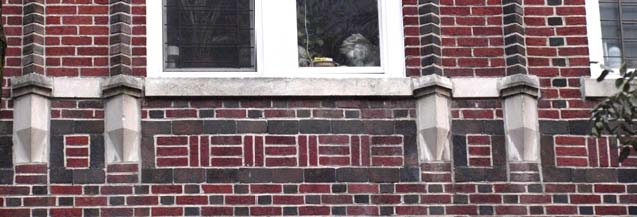
Window decorations
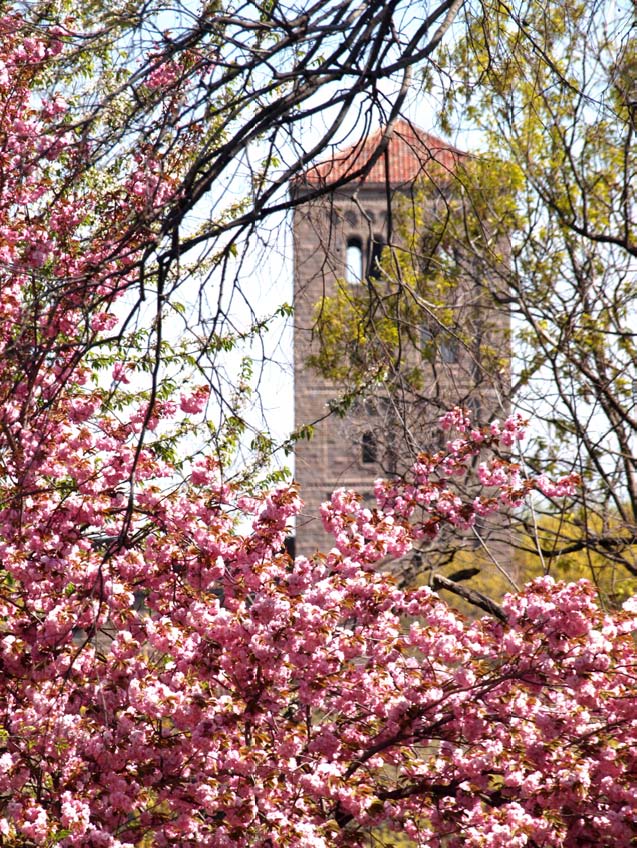
The Cloisters in spring
[9] Hair dressers and beauty parlors
In the vicinity of St. Nicholas and the 181st Street — the High Street of Hudson Heights as the British would say — the most common shops („tiendas“) are probably hair dressers and beauty parlors. Occasionally they are hardly separated by one block. Even more astonishing appears to be that all these places are well-frequented, although sometimes one has the impression, playing on cellular phones helps to overcome the time from one customer to the next.
Of course, one has to recall that barber shops or hair dressers have always and everywhere served as places to catch up with the latest gossip. And „nails & beauty salons“ are not inventions of our time: the wish to have a convincable appearance, to look „beautiful“ (in the context of the local taste) was and is simply a universal feature of human beings. Eyebrows have to be fixed, pedicure and manicure help to lift spirits, just as artificial finger nails extending substantially the finger tips are meant to raise attractivity, not only because of their bright colors, but also because of conditionally applied fancy (prefabricated) artistic patterns.
The trimming of eyebrows and mustaches is part of the additional service male costumers can expect, of course together with the latest news from the neighborhood, juicy jokes and an expertise on current political topics.
For female customers everything becomes more „elaborated“: besides fashionating, the hair occasionally needs to be dyed or beautified with artificial curls. To spend quite some time under a hood bonnet hairdryer, while reading glossy journals, is part of the enjoyment in a beauty salon.
It’s only in „better districts“ that hair dressers tend to be in fancy salons for those pretending to belong to the „upper class“. The technical distinction to those on St. Nicolas, however, is minute: the same type of stools, the same tools. Scissors, combs, razor knives, electric hair trimmers and dryers, are used everywhere, independent of social structures.
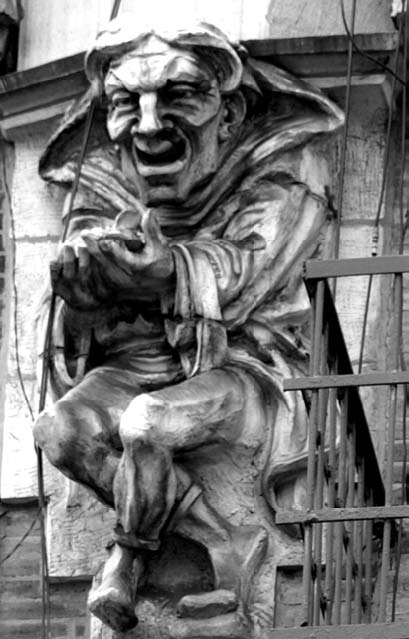
The house with gargoyles, corner of Fort Washington Avenue and 181st Street
[10] Music on the A-train
To reach Hudson Heights starting from somewhere downtown, the most efficient way is to take the A-train, since it runs express between Columbus Circle and 125th Street.
Occasionally it does happen that suddenly Latino music fills the wagons: a middle-aged „musician“ wearing a Stetson hat, western outfit and cowboy boots, quietly steps in at one station, takes his guitar from his shoulder and starts to sing one of those heartbreaking emotional Latino songs usually associated with Mariachi Music(6). He is not a very gifted singer, his mastering of the guitar (of course played with a plectrum) consists of a few guitar chords, sufficient, however, to sound „authentic“. The length of his songs fits nicely the time between two stations, including a collection of money with his hat.
He then swiftly gets out and moves to the next wagon. At the end station of the A-train in Inwood, he probably takes the next train back in direction downtown thus oscillating on one fare per day between the 125th and 207th Street stations, roughly the area with a large Latino population.
The reaction of the passengers usually varies from being moderately delighted or amused to total embarrassment. Some close their eyes in an attempt to wish him not to exist, some put a dollar in his hat before he leaves. The majority of passenger simply ignores him and plays unperturbed on their cells.
Occasionally also other „musicians‚ show up in the A-train: the same type of Latino songs then sound in anticipitation of the street life in the „Dominican Republic“.
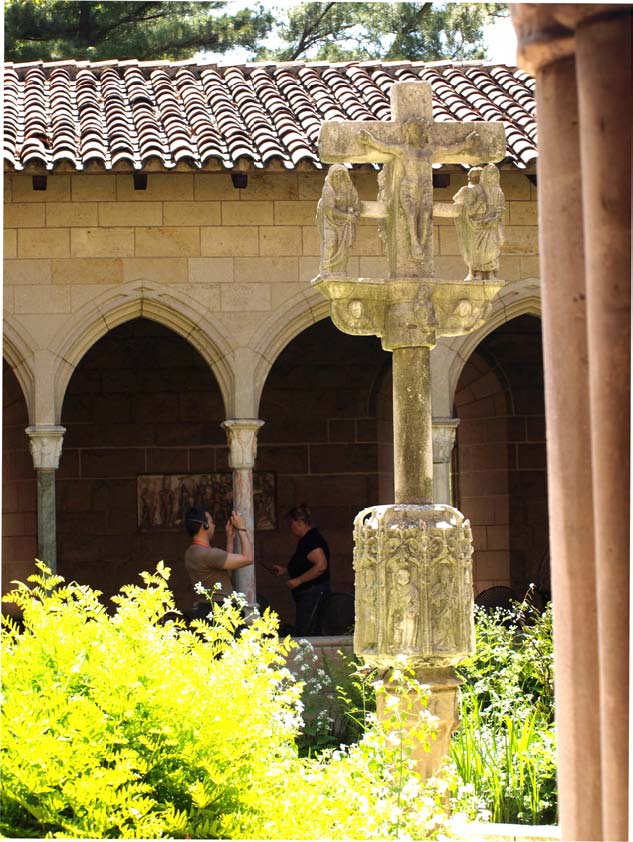
Cloisters in Spring
[11] The house with gargoyles
From the top level of the building at the southeast corner of Fort Washington Avenue with the 181st Street large gargoyles stare down to the street or seem to watch closely the ant-like chaos there. To be precise, it is’nt the kind of gargoyles that traditionally drain water from roofs of romanesque or gothic churches, but rather a set of sculptures and half-reliefs.
And also, not all of them are interested in the human activities near the crossing. One figure, a man wearing glasses with hexagonal frames, simply reads a book. He does not even care about his neighbors, the other sculptures, who like him wear cloaks tightly fixed over their heads. As the expression in his face resembles a stiff grimace, he probably is disgusted or at least worried about what he reads.
Contrary to his fellow sculptures he wears no shoes, his toes stick out below his cloak. What kind of book is he reading? It seems to be fairly thick. Is it a religious text, an apocalyptic story, in which the horrors of the last day are dramatically dealt with? Why is he so distressed?
The other two statues seem to display more openess and friendliness. One of them, a man, offers something in his hands that he thinks he ought to share with everybody else. What is it he wants to share? What can one hold in two open hands? A young bird that fell out of a nest? His open mouth signals amazement. Can it also be something one has to be afraid of?
The third statue, a woman, exposes in a cute girlish manner one of her legs, with her feet being stuck into Renaissance-like boots. She laughs. Perhaps she amuses herself about the two boring men that share with her the fate of being condemned to serve as decorations for a kind of „belle etage“.
Above these three sculptures a repetition of two masks concludes the decorations. One of the masks, a hooded male face shows angryly his tongue to everybody in a most disrespectful manner, while the other one seems to be a relief-portrait of the laughing woman.
Do these two masks depict the two sides of a Janus head? The laughing one symbolizing the future, the angry one the past? Or the other way around?
The style of the sculptures and the masks is indeed very strange. Did the artist try to make fun of his fellow citizens? Does the use of cloaks indicate ridiculous bigottery that needed to be cast into three-dimensional caricatures?
It does indeed pay off to have a close look at that apartment block on Fort Washington Avenue, built in a time, when architecture didn’t have to use prefabricated concrete moduls.
Before running down to the Broadway, one even might be tempted to return the laugh to the stone woman way up.
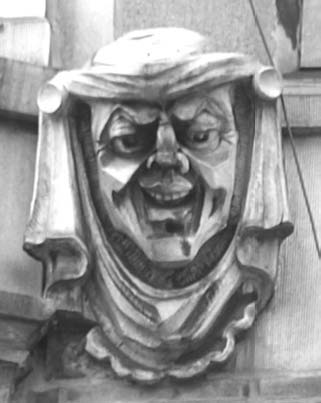
[12] Looking up to the eaves
Hudson Heights is full of buildings that imitate any possibly thinkable style: pseudo-renaissance, pseudo-gothic, pseudoart-deco and „pseudo-all-styles-in-one“ houses form main and side streets in a stochastic manner. Some of them are decorated above the entrance with pieces of industrial art, meant to suggest a higher social standard of their occupants.
In particular, the eaves, way up, just below the roofs, are usually the most artistic parts of a building, sometimes even consisting of semi-reliefs or images of unknown Greek gods. Unknown, because they bear no relevance to the usual appearance of gods in the Greek pantheon.
Unsurprisingly, most houses had been in better shape in former times, were less run-down. To say‚ „they have seen better times“ would correspond to „dreaming backwards“, would refer to a very conservative, if not reactionary view of present day social conditions.
Usually, ordinary people don’t have the patience to look up to the top of the buildings they pass by. Perhaps some of them don’t even care, since at the street level it’s the same kind of shops or tiny „delicatessen“ to be found everywhere. Perhaps, occasionally they should pause for a moment and absorb the faded beauty of the pseudo-style eaves and the imitation of classical Greek glory that are part of the architectural appearance of their own neighborhoods. Some of the eaves are really worthwhile to look at!
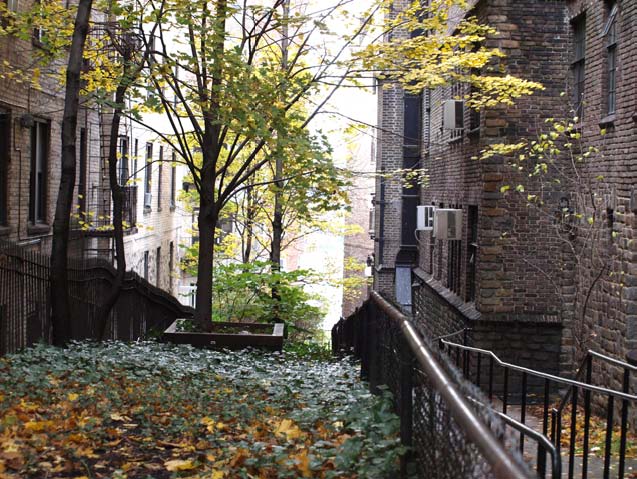
Hudson Heights side lane with the river in the background
[13] The women with a Bowler hat
Occasionally the night before a garbage collection -when already the garbage bags are carried to the pavement in front of all apartment blocks -one can see tiny elderly women, that wear skirts (a pottera(7)) with lots of petticoats, boots and a Bowler hat, opening the garbage bags in search of aluminum cans. Whenever they get hold of such a can, they put it into an enormous plastic bag they drag along. These women belong to an indigenous nation in the Andes and the Altiplano of South America, the Aymara(8) and surely are part of the smallest minority in New York, since even in Bolivia there are only about 1.5 Million Aymaras left. Their ancestors lived in Bolivia, Peru and Chile many centuries before they were conquered by the Incas in the 16th century.
Sometimes one of these women is accompanied by a young one, already dressed in a more city-style fashion, wearing, however, a man’s hat. The Bowler hats are not really used as hats -they are much too small to fit -but as a kind of precious decoration as they are not really cheap. These hats became the traditional outfit of the Cholitas(9), as the Aymara women are called, and serve as an identification with their cultural heritage.
We should indeed be grateful to the Cholitas in our streets searching for aluminum cans as they definitely should not be thrown into ordinary garbage: such cans, batteries and electronic waste have to be disposed properly. A bit of environmental care needs to become generally accepted.
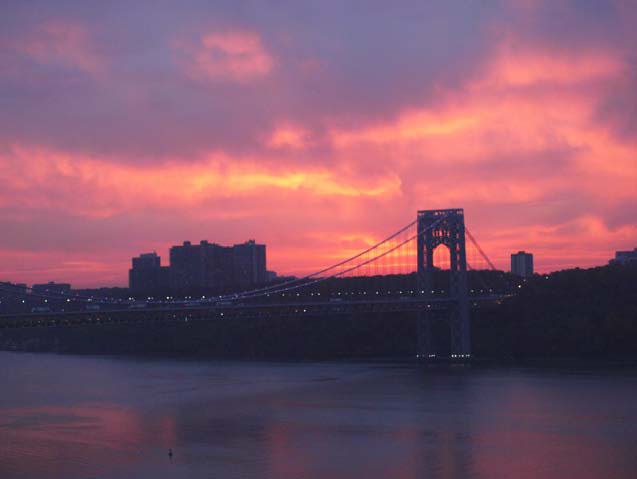
The sun settles down behind the George Washington Bridge
[14] Stair cases
Since Bennett Park — the point of highest altitude in Manhattan — and its surrounding apartment blocks look like a kind of castle hill area that is only easily penetrable via the soft shoulder of the Fort Washington Avenue in direction of 181st Street, one cannot help having the impression that this area appears to be well-separated from the rest of the city. Of course, part of this impression stems from the appearance of the (fake)Tudor-style Hudson View Gardens(10) and Castle Village(11), the name of the five towers sitting on the very edge of the cliff above the river like a medieval castle above the Rhine. Perhaps as an unintended reminder of medieval castle life, there is even a catholic shrine, the St. Frances Xavier Cabrini Shrine(12), very close to Fort Tryon Park.
It seems that the Cabrini Boulevard which also leads down to the 181st Street has to be regarded essentially as a permanent battle ground for parking since only at certain times of the day parcel delivery trucks block occasionally the way. On days of double lane parking, namely, when one side of the street is mechanically cleaned, usually desperate car owners wait sometimes for hours in their cars in order to occupy a close enough parking space for the upcoming week. It’s a kind of irrational weekly duty that has to be carried out.
A bit misleading in terms of through traffic is Pinhurst Avenue that separates Bennett Park from Hudson View Gardens, as it ends in a staircase before reaching the main cross-road: with its surrounding trees and planted flowers this staircase acts like a last farewell to the (relative) silence on top of the castle hill.
Officially the steep staircase from Fort Washington Avenue down to Overlook Terrace is part of 187th Street, a fact that occasionally can be quite misleading when using only a map for driving instructions. Unfortunately, it is not really an intriguing place. Usually litter floats around, the adjacent buildings cause the impression of a rather deprived area. To call that staircase „run down“ is perhaps too much of an oxymoron, but it fits perfectly its appearance.
By the way, don’t be misguided by the promising meaning of the name Overlook Terrace: there is absolutely nothing that can be overlooked from there.
At the bottom of the castle hill the neighborhood changes completely: one enters a mostly Jewish quarter with the Mount Sinai Jewish Center(13), an orthodox Jewish Ashkenazi congregation and the Khal Adath Jeshurun(14) congregation, an orthodox German Jewish Ashkenazi congregation, both occupying the corner of the block facing the Broadway. The community belonging to Khal Adath Jeshurun is usually called the Breuers(15). They run their own schools and kindergarten, parts of Bennett Avenue belong to their realm. As the castle hill area houses predominately „Anglos“, („Reform“-) Jews, a few Hispanics and African-Americans, a suddenly felt cultural clash is immediately experienced when coming down the staircase on a late Friday afternoon. Amazingly: this staircase is capable of bridging in a few minutes walking time more than 150 years in Jewish tradition.
Crossing the Broadway, now again up-hill, one enters a completely different world, the „Dominican Republic“.
[15] Hudson Heights and it’s dogs
There are certain times of the day when mostly dogs and their owners are on the streets, namely on their way to satisfy canine needs. One has to admit everything is carried out in a well-organized manner, since appropriate plastic bags are to be found everywhere in supply containers within reasonable reach. This, however, is only a kind of security measure as it seems to be the pride of all dog owners to carry a poo bag with them.
Independent of countries or even continents it is interesting to observe what kind of dog is on leash with what owner. Mathematically speaking this statement is not quite correct, since frequently dog owners are dragged along by two or more dogs. Occasionally one can see even a dog walker with a whole bunch of dogs of different sizes.
Then — not to forget — there is also a „dog parlor“ in Fort Tryon Park, where it isn’t quite clear who enjoys that fenced place more, the dogs or their owners. The owners because of dog related conversations or the dogs catching balls or frisbees. And of course there is a special event in late fall: „Howloween“, when the dogs have to wear T-shirts or other fancy garments.
The dogs and their owners, they generate the impression that Hudson Heights with all its apartment blocks and thousands of people living there is nothing but another kind of „Our (little) town(16)“, a place where hardly anything changes, perhaps with the exception of a few eating places that, however, reopen almost unchanged a few month later under a different management.
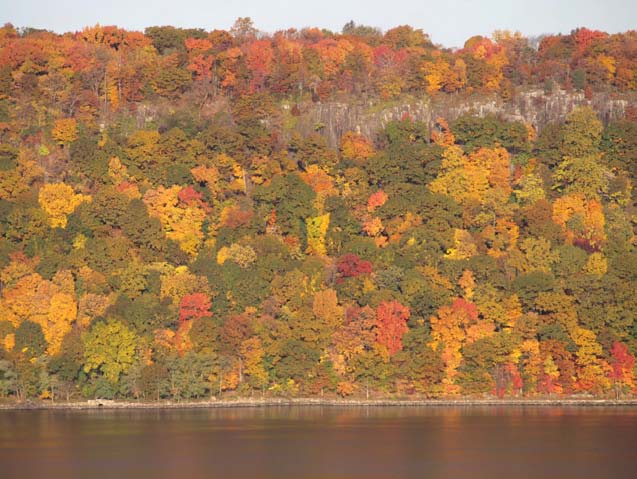
The Palisades in fall
[16] The bench
The impression of Hudson Heights being nothing but another „Our (little) Town“ is enforced by that semi-circular bench in the middle of the traffic island that characterizes the crossing of 187th Street with Cabrini Boulevard.
As soon as the weather permits one to sit outside, this bench is occupied from morning to late in the evening by people from the close neighborhood. Although I never tried to listen to the conversations going on, I am sure, the exchange of news or gossip is essential for the peaceful atmosphere of that place.
Very often elderly disabled people with their walkers or helps meet there, probably to recall memories of much better days, of days when — in their mind — everything was much easier.
There is no doubt that this bench serves a very important social purpose. Like in former times in East European villages, where the village bench was the center of attraction, the chattering can go on for many hours.
One might just as well state that winter is not only the time of cold and unpleasant weather, but also of no-gossiping on that bench.
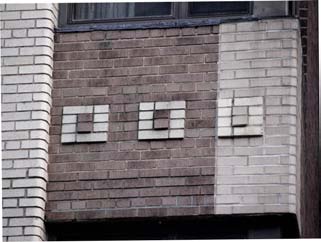
House facade in the neighborhood of the bench

The Palisades covered with snow
[17] Jewish communities
Joseph Breuer is claimed(15), for example, for having been a Rabbi of „German-Jewish refugees fleeing Nazi oppression that had settled in Washington Heights“. The Fort Tryon Jewish Center (Reform), on the other hand, is said(17) having been founded in 1938 by „long-time residents of the city and refugees from Nazi Germany“.
Coming from 181st Street underground station and walking towards the „castle hill High Street“, 187th Street, one passes the Hebrew Tabernacle at the corner of 186th Street and Fort Washington Avenue that also claims(18) that „after the Holocaust German Jews found a new home there“.
Since 2015 the Fort Tryon Jewish Center gathers in the Social Hall of the Hebrew Tabernacle, which serves quite a lot of social purposes such as providing space for charitable rummage sales or for free influenza vaccinations every fall. In this sense the Hebrew Tabernacle serves as a kind of community center within the castle hill area, which seems to be „beleaguered“ by orthodox communities in its lower parts.
Quite a few decades have passed since 1933. It appears useless to try to put actual numbers behind the claims of the various Jewish denominations about their „German Jewish“ members, since — as is well-known — many of the refugees were also non-religious Jews. Historical claims reduce sometimes to a well-intended myth.
The same reservations apply to the colloquial terms „German Jews“ or „Frankfurt on the Hudon“ for Washington Heights as quite a few of those who settled in Washington Heights and, in particular, in the Hudson Heights, were refugees from Austria or Czechoslovakia. The expression „German Jews“ probably stands for „German speaking Jews“, although the „Austrian German“ and the German spoken in Prague („Kafka’s German“) are as different from „German German“ as is British English from American English.
Both, those born in Germany(19) and those born in Austria(20) had in common usually not to speak or even understand Yiddish, as Yiddish was considered to be the language of „backward Easteuropean“ (mostly Chassidic) Jews coming from Poland, Galicia, the Bukowina, the Baltic States or Russia. Both groups, however, referred to their living quarters as „Das Vierte Reich“. In many cases it was simply the cultural self-conception that mattered.
The „Aufbau“, for example, a well-known in 1934 founded newspaper(21) appearing in German had a long list of famous board members such as for example Albert Einstein, Thomas Mann and Stefan Zweig, or, equally famous contributors(22). Editor-in-chief from 1939 on was Manfred George.
This illustrous list of famous names can be augmented by many more artists (musicians, painters, authors, actors) or scientists arriving in New York between 1933 and 1940. The „Aufbau“ simply reflected the intellectual background of many immigrants, who had to leave their homes in Europe. Among the contributors to that journal only Martin Buber and Gershom Scholem persued religious intensions.
And there were quite a few places in town in which European-style entertainment was offered. The Café Alt Wien (323 East 79th Street), the Café Old Europe (2182 Broadway) or Lublo’s Palmgarden (3785 Broaday), for example, not only housed cabarets(23) (with performances on two pianos), but were also the prefered meeting places of well-known refugees such as Otto von Habsburg, the famous violinist Fritz Kreisler and many others.
Stefan Zweig’s „World of Yesterday“ seems to have continued unvolutarily in various parts of New York, in particular in the „Fourth Reich“. His „World of Yesterday“ had very little in common with organized religious life in Jewish communities. His written German was not „at home“ in Frankfurt, nor was that of his friend Joseph Roth, one of the most fascinating authors of the 20th century.
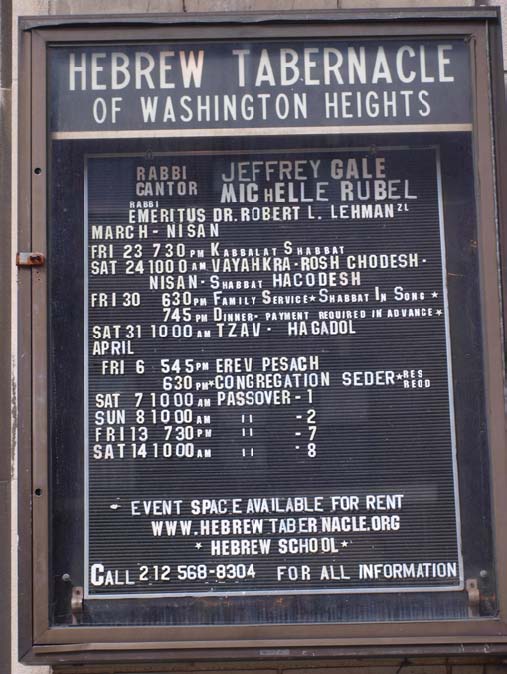
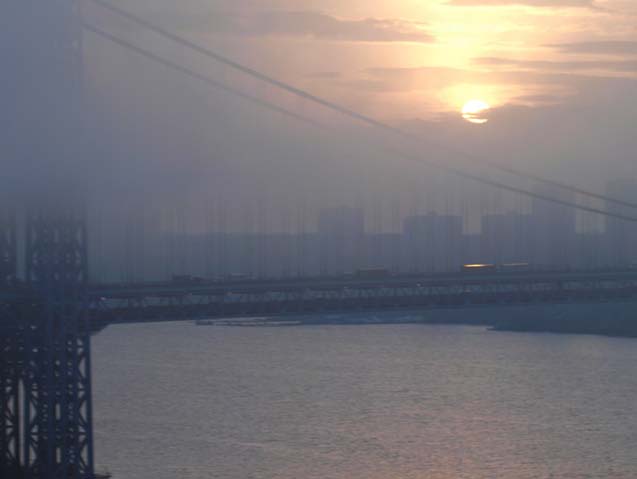
A hazy late afternoon in the Heights
[18] Churches
There are altogether 12 chuches in Hudson Hights and it’s close vicinity, not counting those a bit further off. While an identification of a church as „Roman Catholic(24)“ or „Greek Orthodox(25)“ is unambiguous, a straight forward classification of Protestant churches(26−33), is simply impossible because of the complicated history(26) of such churches after the Civil War. Most of the rather well-known denominations like the Evangelical Lutheran Church(28), the Protestant Episcopal Church(29), the Presbyterian Church(30) or the Baptist Church(31) are present in the Heights and usually provide community centers, Bible classes and other „social services“. It should be mentioned that even an Armenian Apostolic Church(34) is nearby.
Viewed historically, the Baptists moved after the Civil War from the south to the northern parts of the country, whereas
— as a consequence of newly stated dogmas -an increasing number of Protestant or Calvinistic denominations arose from related ones originally centered in the north. Sometimes differences mattered in the question of how to view the Bible as a historically correct text. Different Bible translations added to the diversity of denominations. It seems that in particular the (peculiar absolutistic) language used in some of these translations triggered off additional beliefs and dogmas. Any source specific or historistic-comparative approach to the „original Greek“ version of the Bible, the „Septuaginta(35)“, was never intended nor wanted. This is of course also the case of various Catholic(36) or Greek-orthodox dogmas.
Quite a few of these churches serve as concert halls and therefore add to the cultural awareness in the Heights. Very often such concerts reflect considerable musical professionalty, however, it also can happen that the artistic approach to certain pieces turns out to be too „pedestrian“. Part of the cultural life in the Heights is located in churches, since there is no public community center for social activities.
The exterior of most churches fits perfectly to the architectural „pot-pourri“ in the Heights, their interiors radiate very often a slightly faded view of Christianity based on continuity and solidity in faith.
None of the local churches can be called an architectural beauty or novelty. They are simply an unspectacular part of that entity called Hudson Heights.
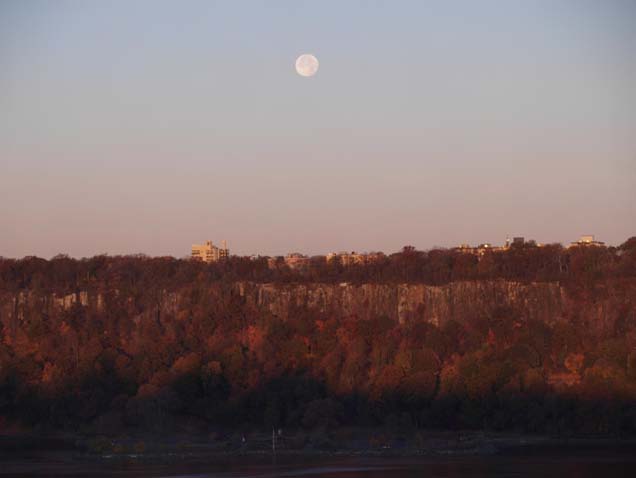
Sunrise and moon over the Palisades
[19] Bennett Park
Passing by the playground in Bennett Park is for quite a few living close by the fastest way to get to the 181st Street subway station. In doing so, it’s one of the pleasures the castle hill provides to listen to the happy voices of mostly small children, occasionally hear them crying and watch grown-ups push endlessly the swings.
There is also enough space for the kids to run around or use tricycles on the path that engulfs a small lawn and a play field in the middle of the park, where a rock sits, whose tip is actually the highest point in Manhattan (281 ft or 81m).
On the Pinehurst side, next to the entrance there, a few benches wait for elderly people from the neighboring apartment blocks to meet. The opposite side seems to be rather a gathering point for half-grown-ups. Both sides are well used.
By the way, the playground dates back as far as to the 1940s, the service building, however, is much younger (1964). Generations of kids must have used already the jungle gym and the swings with the same kind of laughing and shouting since decades.
Probably most locals don’t know that the Park is named(37) after the New York publisher James Gordon Bennett, Sr., who founded the New York Herald in 1835. He purchased the hill that once served as „Fort Washington“ military purposes. It’s not really essential to know this, since the playground nowadays is much more important than all historical reminiscences. The fact that hardly anybody ever looks at the plaque outside of the park, sitting there in an impressive marble frame, is sufficient proof for this persistent ahistorical attitude.
In crossing the park it occasionally can happen being run over by one of the world’s fastest tricyclists or getting hit by a misaimed frisbee. Don’t mind! Bennett Park is predominantly a place for small children, adults are only tolerated there as long as they don’t interfere too much.
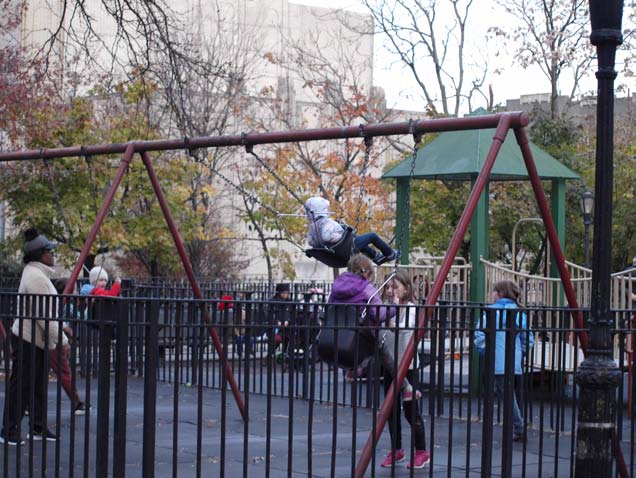
[20] Castle Village
Since Castle Village is such a prominent place in Hudson Heights, and also, as since years scaffolding became part of its permanent appearance, a little mathematical exercise can serve as perthaps new or surprising view of these five blocks sitting on the edge of the cliff over the Hudson, namely to answer the question of how many inhabitants are actually living there.
Each block has 11 levels and a penthouse floor, in each floor there are 9 apartments. The total number of apartments in Castle Village (at least according to the plans(11)) is therefore 9 x 12 x 5 = 540. Assuming on the average 2 inhabitants per apartment, yields a total of 1 080 people living there, with 3 inhabitants, it would be 1620.
Consider for matters of simplicity that about 1 500 people, children included, run in and out Castle Village every day. This number might sound big or small unless it is gauged with the total number of inhabitants in Hudson Heights. According to the 2010 census the population there was 29 000. Simplifying again and assuming its now 30 000, this suggests that every 20th person in Hudson Heights lives in Castle Village.
This is indeed a bit surprising. Of course, it does not mean that every 20th person one encounters on Fort Washington Avenue must live in Castle Village or every 40th is Hispanic, since the same census counts about 45% Hispanics and 45% Non-Hispanics.
Think of a village somewhere in the countryside, for example, in the Catskills. Such a village with about 1500 inhabitants most likely consists of about 500 one family homes (3 persons per home). Assuming that each home sits on a quarter of an acre property, the size of such a village considering only the family homes would be 125 acres. Castle Village comprises altogether only 7.5 acres(42) (or, 200 inhabitants per acre). Again surprising?
The next time you pass by Castle Village think about these numbers. They tell you perhaps more about this place than stories of its history or the collapse of its retaining wall in 2005.
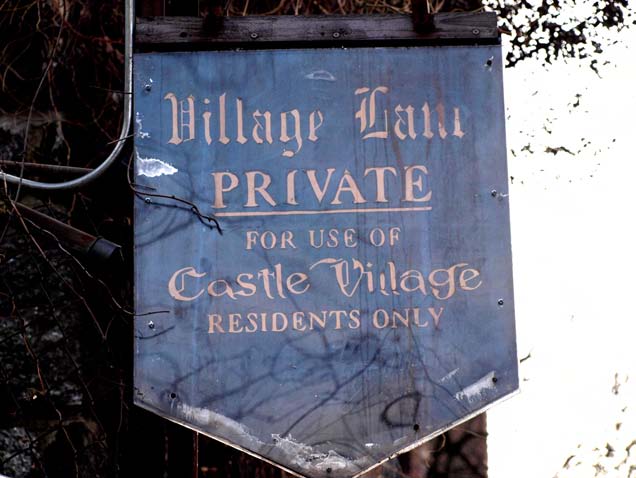
[21] In the lobby of a large appartment block
Alejandro, doorman, of Hispanic origin, Jason, UPS(38) deliverer, Afroamerican
[Alejandro] Hey, here comes Jason, the UPS packhorse! What kind of shmutz are you shlepping in today?
[Jason] Shut up, Alejandro! Why can’t you simply say Good Morning like a decent human being? Take a jalapeno and stick it up your ass, if you need an early morning excitement! . . . . Say, is there a Mrs. Blumenthal living in your block? It seems — for the first time ever — I have a small parcel for her.
[Alejandro] You mean Doris Blumenthal, our little old sweetie? She’s such a nice old lady! I never saw her file complains about us doormen like most of the others. I tell you, it’s a bunch of shmocks living around here.
[Jason] Doris Blumenthal, that’s what the address says. Maybe it’s a sort of official notice. Look at all the stamps and seals on the envelope! . . . . Anyhow, I am not yet finished, I have a few more boxes to carry in.
[Alejandro] Wow, wow, wow, man! What is all that shit you wheel in? Look at this! A gigantic television set for the Gonzales! I bet that screen is bigger than their whole apartment. From now on they have to sleep hanging from the ceiling or to camp out in their tiny bathroom.
[Jason] It’s none of your business, man, to ask what they will do with that fucking screen. Let them have it hang out from the window, if they want to do that.
[Alejandro] Anyhow, that letter for Mrs. Blumenthal. I will carry it up to her as soon as you leave . . . . . You bet, I won’t help the Gonzales to shlepp this shitty monster upstairs . . . .
. Ok, this is it for today? No more fucking surprises left in your truck? Well, then, what’s new in the outer world?
[Jason] Did you ever see big changes in this neighborhood? Every morning the same dogs shit on the same pavements. You should see the relieved faces of their owners, when they pick up the shit. Big amusement! To shovel dog shit in a plastic bag! Must be their great moment of the day! . . . . By the way, some corners in this neighborhood stink like an outdoor pish-house: all those dogs prefer the same places . . . . . Just imagine, I saw Rosalita from next door wobble in direction of the subway station. Every time I see her, I have to stop my truck and watch the spectacle her ass is offering to the general public: each cheek of her backside is popping up and down at least five inches! I bet that ass alone weighs a 100 pounds. She probably enjoys that Polka her ass is dancing. I sometimes wonder, how she gets down to her pussy.
[Alejandro] Hey, you really seem to get aroused by big women’s big asses. Why don’t you go and fuck her? I am sure only a pack horse like you can handle her dancing cheeks.
[Jason] Chinga tu madre, Alejandro! Who cares for a XXXL-size snatch? . . . . . Incidentally, I am sure you know her: just before getting out of my truck in front of your building, I saw that antique cowgirl: Granma Moses on her way to the local Rodeo! Looked like a ghost from Texas with her blond wig, leather pants, cowboy boots and fancy Stetson. Must be a real moron that woman to walk like this in the streets.
[Alejandro] We call her Mrs. Alzheimer, since she has some „heimer“ in her name. Well, poor thing, she virtually has nobody around her. No relatives. Nothing. Therefore she desperately tries to look 60 years younger than she actually is.
Strange creature! . . . . Oh, I have to tell you, yesterday night we had quite some fun here in this building. The Johnsons had again a big fight. Both were screaming at each other, one clearly could hear plates and glasses crash on walls. The whole building was up. All thought he eventually will kill her. Somebody must have rang up the police. They booked them both in. It was unusually quiet, once they had them squeezed into police cars. One literally could hear Sam Broider in the eighth floor fart in his apartment . . . . . Will you have to come again in the afternoon?
[Jason] You should know better, wise guy, that I am on duty only in the morning. Every day the same fucking question! You think its big fun to pick up early in the morning all those boxes from our distribution center. And then to deal with all the fucking doormen in this neighborhood. Some of them probably think they have balls of the size of a soccer ball. The biggest asshole of all of them is that fart from that yellowish house, since he insists that I have to carry up all packages saying doorstep delivery. Holy cow! All he does is to sit on his fat ass all day long. He must have already blisters on his rear end from not moving his butt! That guy is as friendly as a bull terrier in attack. Our whole crew refers to him as Mr. Shithouse. What a fucking bastard!
[Alejandro] Wow, wow, wow, Jason, slow down! You don’t have to complain to me about him. I know he is a major league asshole . . . . Listen, when touring around did you see that the small take-way Chinese place at the cross road has closed? They must be broke! Unfortunately, it’s just another small eatery that shut down recently. Not that I was too fond of that place, but they offered the by far cheapest lunch menu in the whole area. And that mattered to many people.
[Jason] I saw that! I also saw that next to it a kind of dinner opened up just now, serving the usual crap: burgers with greasy chips . . . . . Since we were talking about women, you guys seem to have a new tenant? A crushing beauty!
[Alejandro] You mean JJ? Jennifer Jackson? I tell you that woman makes my day when she walks in or out of the lobby. Her tits seem to pop out any moment from that kind of tight tops she’s wearing. I love to see her behind vanish in the elevator. Every single one of us doormen gets weak in his knees when she shows up. You should hear them: Good morning, Mrs. Jackson! How are you today? Is there anything I can do for you? It’s sick! That honey-bee-tree-like talk they rush to produce! It’s disgusting!
[Jason] Are you jealous not being the only one that adores her? Hey, even I belong to that club . . . . . I hate this phone that I am supposed carry on my tour. They keep pestering me with messages. Just now my boss asks, where the fuck I am! Seems I have to leave immediately. Nice, talking to you, Alejandro!
[Alejandro] To hell with you, Jason! I am already cursing tomorrow’s morning when you show up again with that wrapped up shit you guys bring in. Give me a break for at least a day! . . . . . Take care, Jason! I warn you: leave JJ alone!
[22] The M4 Bus
No question: the M4 bus is an integral part of the feeling being at home in the Hudson Heights. Right in front of the entrance to Fort Tryon Park, the drivers usually take a few minutes lasting break, occasionally smoke a cigarette, before they head off again towards down-town, in direction of the traffic jungle in Midtown Manhattan.
The M4 serves as a kind of local means of traffic as it stops every second block. Only very few passengers use the bus for longer distance rides, some of them, however, have to do so, because they physically cannot manage to climb down the rather steep staircases to the subway.
The interior of the M4 — like most other MTA buses — is extremely plain: blue hard plastic seats, enough handles for standing passengers and a facility to fix a wheelchair. The ticket machine is next to the driver. Equally scarce is the decoration: a few adds and warning signs („no spitting“) are the only beautifications to be seen. Really disturbing can be the air condition blowing in full blast above some of the seats. In particular in summer these seats are unusable.
During the day mostly women and elderly persons use the bus: to save walking a few blocks on George Washington Avenue, or, perhaps to go shopping. Like in the subway the preferred color of garments of the passengers during the cold season is a kind of universal greyish-black or fading brown. Mostly anoraks or jackets and jeans are worn. And sport shoes of rather cheap make.
In going from mid-town to up-town, below approximately the 125th Street, most likely a busy come and go happens. Then the number of passengers starts to decrease successively with most of the „Latinos“ getting out at or near the 175th Street, while the few remaining „Anglos“ in the bus usually continue to the top of the castle area.
The sight of an M4 bus on George Washington Avenue is so common that one hardly realizes anymore that a bus is actually passing by.
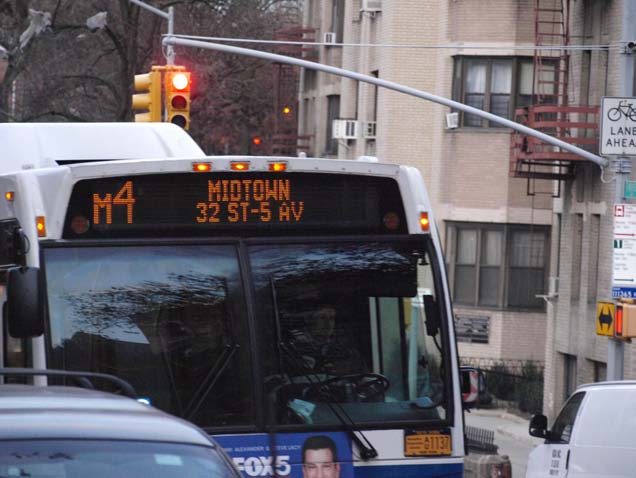
[23] E-bikers and delivery trucks
Like the M4 bus a fleet of deliverers on bikes belongs to the standard view of street live in Hudson Heights. In particular, starting from late in the afternoon up to well beyond nine o’clock in the evening, one can see them delivering in heat preserving containers Mexican or Chinese food, boxes with pizzas or Hamburgers with fries.
Now, since they are using e-bikes, they move around really fast, not caring about traffic rules, whatsoever. The plastic bags they used to have fixed to the handle in order to cover the brakes and gear shifts once it gets cold, have changed to special, professionally looking mittens. In winter they are covered up completely: only the eyes and the nose remain visible. The helmet they wear on top of a thick woolen hat. To deliver food is usually the only type of job unskilled labor with no technical skills at all can perform.
Another familiar sight on the streets are the delivery trucks of the various companies that operate in Hudson Heights like everywhere else in the city. About 1.5 million packages a day are presently delivered(39) in New York, an amount that still increases substantially. These delivery trucks not only cause substantial traffic jams in downtown areas because of double lane parking, but also create an enormous environmental problem due to enhanced CO2 emission. The positive effect on the job market -more trucks need more drivers — might turn out to be too high a price to be paid in the future.
At least the e-bikes on the streets should be „clean“, one would hope, perhaps despite a vague suspicion that their batteries might be charged using „energy“ of unknown origin.
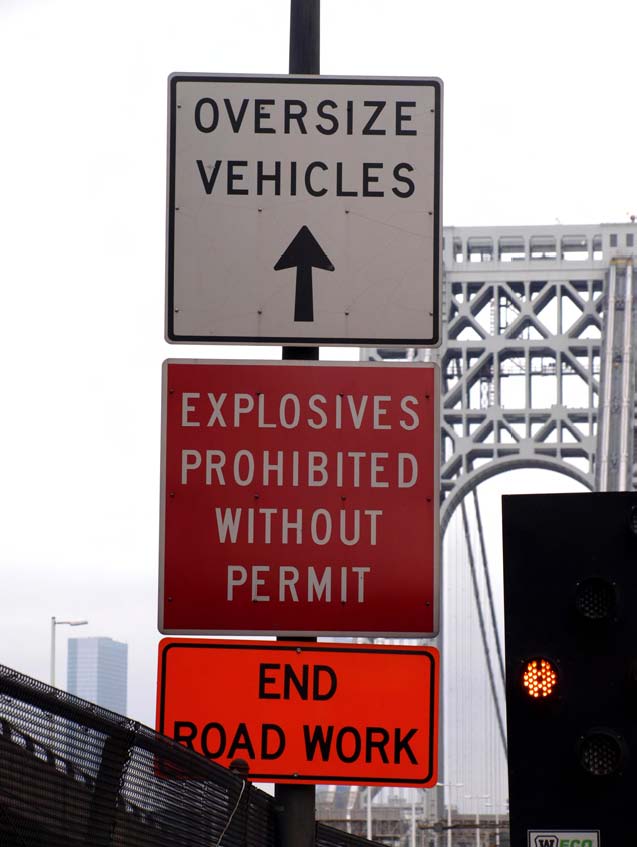
Traffic signs
[24] The George Washington Bridge
There is hardly anyone who wouldn’t agree that the George Washington Bridge(40) is the most prominent landmark in Hudson Heights. It is the most important point of entry to New York City for all goods coming from the West via New Jersey, it is the most heavily used bridge in the whole of the US, it is well-known for (very) slow traffic not only during peak hours, for hefty tolls(41), and so on. It is also well-known for permanent traffic accidents and most likely millions of swearwords muttered in trucker cabins. All this, plus the technical or historical details, is only one way to the view the bridge.
However, there is yet another side, another aspect to the „GW“ as this bridge can be seen from many points and under different circumstances in Hudson Heights. It’s a bridge with many „faces“, as it can hide in dense fog showing just about the contours of its steel construction, it can put on a spectacular sunset, painting the New Jersey banks in dark yellow or red. There can be days in fall (not very often), when fog fills the valley of the Hudson just up to the rim of the Palisades such that only the top of the bridge reflects bright sunshine. It can transmit well-feeling on clear days when a blue sky is reflected in the Hudson, or, miserable moods when the world behind the bridge seems to be dipped into some universal rain-driven grey.
What ever „face“ the bridge puts on, it looks completely different from various viewpoints. Seen from Fort Tryon Park some of these „faces“ are season dependent. A brisk early spring day with just a little bit of green decorating the trees offers a different view of the „GW“ as seen from the same spot when these trees have already put on their fall cloth.
And seen from tInwood Hill Park, with the Cloisters in the foreground provides yet another familiarity with the bridge.
The 175th Street and the monstrous highway that cut the Hudson Heights into two parts, act like a huge reflection plane in the landscape, since -like the two sides of a coin -there is a view of the bridge as seen from south of the 175th Street and one north of it. Views onto the bridge from the corners of that street with the Fort Washington Avenue are usually little rewarding as on its entrance side, for example, mostly a post with three traffic signs is visible. One of these traffic signs strangely states „EXPLOSIVES PROHIBTED WITHOUT PERMIT“.
Since the entrance to the Henry Hudson Parkway occupies quite a large area, the best views on the bridge as seen from the south is hiking down to the Riverside Park, which essentially ends under the bridge with no continuing path to the north. There, almost at the banks of the river, the bridge once again is part of the landscape with -as in Fort Tryon Park -its different seasonal „faces“. Only one geographical exception does apply: sunrises and sunsets look different as viewed from south or north of the bridge. However, in both directions sunsets can be spectacular.
On certain national holidays, special lighting flashes on at night that coats the towers of the bridge in brilliant white. On such an occasion the headlights of the cars and trucks merely look like fast moving candles.
[25] The Fort Tryon Park
There is a famous story by the Argentinian writer Jorge Louis Borges entitled „The Garden of the Forking Paths“(42). Almost the same can be said about Fort Tryon Park(43): it is a park of bifurcated trails, with staircases leading at a first glance to nowhere, covering, however, randomly the steep slope down to Broadway. Like in a proper labyrinth even dead ends can be encountered.
Already a few steps away from the entrance the path splits into various sections with some of them reuniting later on. One can either walk through a small area bordered on both sides with flower beds, heading directly to a tree that in spring is covered with a cascade of pink blossoms, or, take the main trail to an outlook terrace with a view in direction of the Bronx, or, walk down on the riverside path. However, even the riverside path splits almost immediately into two branches. Both offer a staggering view onto George Washington Bridge that spans the river like a gigantic steel bracelet. Similar to contributors to a river most of these paths join before a bridge over a steep gorge, the bottom of which serves as an entrance to the Henry Hudson Parkway.
Having crossed that bridge a large meadow shields the Cloisters, prominently positioned at the top of its own hill, from the rest of the park. A road has to be crossed to get to a small path that leads to a side entrance of the Cloisters. Alternatively, that path can be continued to the main entrance.
Leaving the Cloisters aside and following the main path finally the lower parts of the park, namely those along Broadway, can be reached, from where quite a few stairs and trails lead again up the hill. As already said, it is a maze of interconnected paths, encircling the two hills that form the park. The large playground down there, located in the corner of Broadway and Riverside Drive has a section for small children and -as a rare facility -public conveniences.
Not mentioned up to now was the path that starts at the entrance and bypasses the Café: there, a row of benches invites to sit down for a while to enjoy for example the warmth of the sun on a clear late fall day. Since a small Russian minority is still present in Hudson Heights, one can hear occasionally elderly women sitting on one of those benches use Russian to talk to their grandchildren or friends. Because any language other than English and Spanish got to be Russian in the Heights, this path is sometimes nicknamed „Russian Alley“. The former predominant language, German, has vanished almost completely(44).
Probably less known is the fact that also the Javits playground(45) and the terrace below the 190st Street subway station belong to the premises of Fort Tryon Park. The oversized round-about at the very end of Fort Washington Avenue separates these parts from each other: a completely unnecessary concession to cars and buses. Unfortunately, there is no access to the area of the park that extends along Cabrini Boulevard. Over the years this stretch of land became an unattractive „wilderness“.
Fort Tryon Park transmits a kind of nostalgic feeling back to a time when gas light lamp posts throughout the whole area invited for evening strolls, although in the further past the two hills were less peaceful: the park is named after Sir William Tryon, the last British governor of the province of New York and was the site of the British fort opposing Washington’s fort in present days Bennett Park.
[26] The Cloisters
There is one thing peculiar about the Cloisters(46): they transmit tranquility. A time gap of almost a thousand years serves as a kind of buffer between a present-day consciousness and a most likely little-known period in history, the age of the romanesque style, the time of the Crusades. A strange feeling pertains discovering suddenly features in art objects with obvious iconographic messages. Perhaps in quite a few cases we no longer understand these messages and classify certain pieces simply in terms of the aesthetics of our century.
Some of the „annunciations“, for example, look just „beautiful“, although the presence of an angel does not fit in the present days technocratic realism. But are we really as rational as we think we are? Isn’t it that millions of people believe that every single word in the Bible is absolutely true and therefore angels must have existed? Still exist today? Don’t we have to admit at least that these angels are „beautiful beings“?
The cloisters should not be visited only as a place of romanesque and early gothic art. Quite a few of the hidden messages — the ones we don’t understand — do reach up into our time. The idea of an apocalypse, for example, didn’t vanish. In fact, in the last 150 years, even in the 20th century, in the US several dates for the day of the return of Christ were suggested by some denominations — and clearly didn’t occur. A return with all the circumstances envisaged in former centuries such as the appearance of an Antichrist and angles blowing a shofar as a kind of an overture to Doomsday?
Most of us probably no longer think that Behemoth(47) and Leviathan(48) or Gog and Magog(49) are to be expected before that day to fight the „last battle“ between „good“ and „bad“. We have deliberately already created our own, very realistic apocalypse: a most probable climate collapse to hit future generations. Obviously Gog and Magog fulfill nowadays the play-book of „scientific evidence deniers“ and „scientific theologists“.
The Cloisters are a very peaceful place, full of beautiful romanesque artefacts well displayed. The tranquility there should induce contemplations about our own hidden messages, about the future of man-kind per se. To simply laugh about depicted devils with more than one ugly head or dragon-like extremities would be the wrong reaction: our own, self-made „devils“ have a half lifetime of about 20 000 years such as Plutonium. We even store these „devils“ carefully as self-deterrents.
The Cloisters should remind us also of the fact that the Crusades — the wars against the „infidels“ — were only one incident of wars in what nowadays is called the „Middle East“. The „Middle East“ was (for at least the last 4000 years), still is and will remain a war-zone.
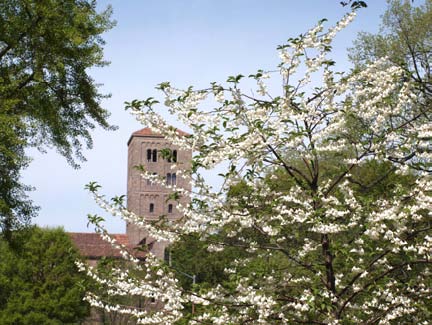
The cloisters in spring
[27] Beyond Fort Tryon Park
Beyond Fort Tryon Park, a largely unperturbed wooded hill — the Inwood Hill Park — extends up to the East River. Crossing Riverside Drive, the northern boundary of the Fort Tryon Park, a two blockwide stretch on Payson Avenue leads to Dyckman Street, a cul de sac in direction of the Hudson. There, beyond that street, the path through Inwood Hill Park starts. Inwood was like Washington Heights, one of the areas, where quite a few German and Austrian refugees settled.
Walking a bit up-hill on Payson, the eastern border of that park, offers an interesting view of the “Bell Tower” of the Cloisters and of the George Washington Bridge. It must be exactly this spot from which a Austrian Painter by the name of Trude Waehner started to depict images of this view. She painted winter scenes with snow covering the ground or the Fort Tryon Park hill in bright spring or summer light. Trude Waehner(50), before 1938 already well-known in Europe for her artistic skills, was a long-life friend of Josef Frank(51), one of the most well-known architects of the 20th century. When he came to the United States during World War II, he first stayed with her until she found an apartment for him in the close neighborhood. Instead of seeing him hang around due to the lack of commissions, she introduced him to the technique of watercolors, an approach well used in designing.
Frank must have spent many hours in the then newly opened Cloisters studying in particular the tapestries called “The Hunt of the Unicorn”, dating from the turn of the 15th to the 16th century. In particular the background in these tapestries, the fancy colorful flowers and exotic plants, seem to have impressed him immensely. They gave him the idea of using such patterns for the design of upholstery fabrics(52), that upto-now are still en vogue and manufactured by a specialized Swedish firm.
The Inwood Hill Park seems to be virtually unknown to most New Yorkers: besides occasional dog walkers, one hardly meets any other human being there. Unicorns, on the other hand, still frolick happily in quite a few ideological gardens. Beautified symbols of irrationalism don’t seem to have vanished in our computerized world.
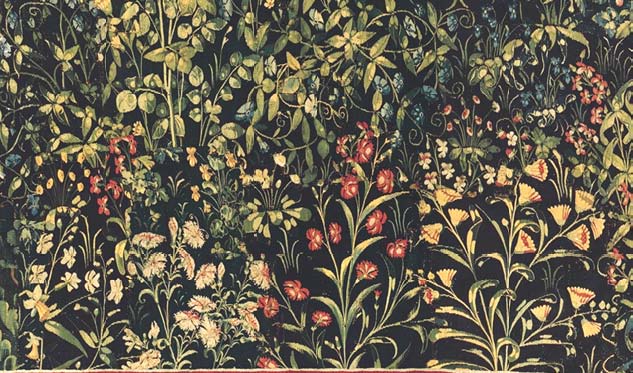
„The History of the Unicorn“, Detail, The Cloisters
[28] Land’s end
There is hardly anyone -tourists included — that has not experienced the incredible view from the Battery Park onto the New York Bay. The Statue of Liberty, Ellis Island, Staten Island and Governors Island, a chain of islands forms a panorama pretty familiar to nearly everybody. The other end of Manhattan, however, seems to be virtually unknown even to most New Yorkers. It’s a little dip hanging out in the Hudson at the very end of the Inwood Hill Park Game Field, separated from Spuyten Duyvil by the entrance to the East River.
To reach this tip is not easy at all, because one either has to walk quite a bit from the Dyckman Street subway station and then cross all the game facilities, or use a bike. It’s very quiet up there — no tourists, no ticket sellers to the Statue of Liberty ferry — only very few locals or bikers occasionally show up.
Standing almost at the level of the river, one can see most prominently the George Washington Bridge, the Tappen Zee Bridge river upwards and the massive wall forming the New Jersey river banks, the Palisades. On a bright day during Indian Summer the Palisades turn into a dense pattern of bright yellow, red and brown color spots. Although the tide reaches up even beyond this point, the Hudson on such a day is dipped in glittering blue, hiding thus all the pollution this river suffers from.
As already said, it is a quiet place in as much as anything can be quiet on New York standards: one still can hear the traffic noise from Henry Hudson Parkway that crosses the East River nearby. „Land’s end“ makes one forget that it is still part of Manhattan.
Unfortunately, the silent beauty of the northern tip of Manhattan is spoiled by the view of a run-down railway bridge that cuts off the East River from the Hudson. This bridge surely is a very good candidate in a competition of the ugliest industrial constructions in town.
By the way, visiting the game field on a Sunday during the nice season of the year, one can get a perfect feeling for differences in local cultures. While the baseball fields are mostly used by „Anglos“ and „African Americans“ in a pretended semi-professional manner, the soccer field further up sometimes turns into a Latino street fair. From grandparents to babies, everybody is out there. Dogs run happily between the soccer players, women unpack loads of food to be consumed „in between“: a fiesta is on its way.
Notes
(1) MTA: The Metropolitan Transportation Authority is a public benefit corporation responsible for public transportation in the U.S. state of New York, serving 12 counties in Downstate New York.(2) The film series The Lord of the Rings (https://en.wikipedia.org/wiki/The_Lord_of_the_Rings _(film_series) is based on the fantasy novel by J.R.R. Tolkien. The Lord of the Rings is one of the best-selling novels ever written, with over 150 million copies sold, https://en.wikipedia.org/wiki/The_Lord_of_the_Rings .
(3) Platanos maduros frittos: Batter the sliced platains slightly with a meat hammer before frying them in vegetable oil. Turn them several time still they appear to be crispy brown. Drain the platain slices using a paper towel to remove excess oil. Fried platains can be served instead of fried potatos.
(4) Bacalao salado: Soak the salted cod in water for at least 8 hours changing the water several times. Then arrange layers of peeled potatoes, cod, onion, capers, garlic, roasted red peppers and boil everything for about 20 minutes. Before finishing add tomato past or peeled tomatoes and a few chili flakes. Don’t forget to serve the dish with freshly cut cilantro.
(5) Fernando Botero is a Colombian figurative artist and sculptor. Born in Medellín, his signature style, also known as „Boterismo“, depicts people and figures in large, exaggerated volume, which can represent political criticism or humor, depending on the piece. https://en.wikipedia.org/ wiki/Fernando_Botero. See, for example, the Adam and Eve statues in the hall of the Shops at Columbus Circle, https://www.theshopsatcolumbuscircle.com/adam-eve-the-irresistibletouch-of-temptation/
(6) Mariachi Music: https://en.wikipedia.org/wiki/Mariachi
(7) Pollera: skirt worn by women in Spain acentury ago, https://en.wikipedia.org/wiki/Pollera
(8) Aymara: https://en.wikipedia.org/wiki/Aymara_people#History
(9) Bowler hats and Cholitas: https://travelandkeepfit.com/en/2018/06/29/bolivian-cholitas-andthe-very-weird-story-of-their-bowler-hats/
(10) Hudson View Gardens: https://en.wikipedia.org/wiki/Hudson_View_Gardens
(11) Castle Village: https://en.wikipedia.org/wiki/Castle_Village, http://www.castlevillage.com/
(12) St. Frances Xavier Cabrini Shrine: https://cabrinishrinenyc.org/about-the-shrine/
(13) The Mount Sinai Jewish Center is a modern orthodox synagoge, https://www.mtsinaishul.com/
(14) Khal_Adath_Jeshurun bases its approach, and structure, on Hirsch’s philosophy of the Torah im Derech Eretz; it was reestablished according to the protocol originally drawn in 1850, to which the congregation continues to adhere, https://en.wikipedia.org/wiki/Khal_Adath_Jeshurun .(15) (Joseph) Breuer, the first American Rabbi of this community, https://en.wikipedia.org/wiki/Joseph_Breuer .
(16) My Little Town is a 1975 song by the American duo Simon & Garfunkel, https://en.wikipedia.org/wiki/My_Little_Town . Our Town is a 1938 metatheatrical three-act play by American playwright Thornton Wilder. It tells the story of the fictional American small town of Grover’s Corners between 1901 and 1913 through the everyday lives of its citizens, https://en.wikipedia.org/wiki/Our_Town .(17) Fort Tryon Jewish Center: https://en.wikipedia.org/wiki/Fort_Tryon_Jewish_Center
(18) Hebrew Tabernacle: https://hebrewtabernacle.org/about-us/
(19) „The United States Census of April 1940 counts about 22,400 persons born in Germany in Washington Heights and Inwood ...", Steven M. Loewenstein, The German-Jewish Community of Washington Heights, The Leo Baeck Institute Year Book, Volume 30, Issue 1, January 1985, p246, Footenote 3, first sentence.
(20) „Besides the Germans there were some 5,000 Austrians and 1,000 Czech in 1950, many of whom were also refugees of the 1930s." Loewenstein, p. 246, Footnote 3, last sentence.
(21) Der Aufbau: https://archive.org/details/aufbau
(22) Hannah Arendt, Max Brod, Martin Buber, Oskar Maria Graf, Heinrich Eduard Jacob, Ludwig Marcuse, Hertha Pauli (sister of Wolfgang Pauli), Alfred Polgar, Curt Riess, Hans Sahl, Will Schaber, Gershom Scholem, Helmut Kuhn und Carl Zuckmayer.(23) Cafe Alt Wien: http://othes.univie.ac.at/9151/1/2010-02-23_8903677.pdf , p.132-134.
For all those who enjoy „Viennese German“ in an „Emigranto-context“, here is a song by Hermann Leopoldi, Text: Robert Gilbert, that was first performed in the Cafe Alt Wien:
Jüngst trafen sich zwei Dackel,
It happened in Washington Heights,
Mit fröhlichem Gewackel
Begrüssten sie sich allerseits.
Der eine sprach: Servus, Herr Mannderl,
How are you — I see, not so fine —
Ein Schnitzel hängt halt
Auch hier nicht so bald
Dem Hunderl in’s Munderl hinein!
Mir sagte das Dackel Commitee:
Als Schosshunderl finden’s kann Schoss —
Gehn’s, suchen’s an job in der city!
Doch wo ich mich vorstell’,
A bissl was vorbell’,
Da sagen’s nur: Schau,
Der foreign Wauwau,
Der wird seinen accent nicht los! —
Dabei war ich grösser als gross.
Ich war einmal ein grosser Berhardiner
Over there! Over there! Over there!
(24) Catholic Churches: St. Francis X. Cabrini Shrine St Elizabeth’s Church, 268 Wadsworth Ave, New York, NY 10033; https://stelizabethnyc.org/ Church of the Incarnation, 1290 St Nicholas Ave, New York, NY 10033 https://incarnationnyc.com/
(25) Greek Orthodox Church: St. Spyridon Greek Orthodox Church, 124 Wadsworth Avenue, New York, NY 10033, http://www.saintspyridon.net/(26) Frances FitzGerald, The Evangelicals: The Struggle to Shape America, Simon & Schuster, 2017
(27) Collegiate Reformed Protestant Dutch Church: Fort Washington Collegiate Church, 729 W 181st St, New York, NY 10033 https://www.fortwashingtonchurch.org/
(28) Evangelical Lutheran Church in America: Our Saviour’s Atonement Lutheran Church, 178 Bennett Ave, New York, NY 10040 http://www.osanyc.org/(29) Protestant Episcopal Church: Holyrood Episcopal Church ~Iglesia Santa Cruz, 715 W 179th St, New York, NY 10033 http://www.holyroodsantacruz.org/
(30) Presbyterian Church: Fort Washington Presbyterian Church, 21 Wadsworth Ave, New York, NY 10033 http://www.nycago.org/Organs/NYC/html/FortWashingtonPres.html
(31) Baptist Church: Wadsworth Ave Baptist Church, 210 Wadsworth Ave, New York, NY 10033, http://www.wadsworthnyc.com/(32) Christ Church: Christ Church Washington Heights, 4111 Broadway, New York, NY 10033, https://christchurchnyc.org/
(33) Uptown Community Church, 551 Fort Washington Ave, New York, NY 10033 (Using the Hebrew Tabernacle) http://www.uptowncommunitychurch.com/contact/
(34) Holy Cross Armenian Apostolic Church: Holy Cross Church of Armenia, 580 W 187th St, New York, NY 10033(35) Septuaginta: https://en.wikipedia.org/wiki/Septuagint
(36) The dogma of Mary’s Assumtion was adopted as late as 1951, https://en.wikipedia.org/wiki/Assumption_of_Mary
(37) Bennett Park: https://en.wikipedia.org/wiki/Bennett_Park_(New_York_City) https://www.nycgovparks.org/parks/bennett-park/monuments/721
(38) UPS: United Parcel Service is an American multinational package delivery and supply chain management company.(39) New York Times, November 10, 2019
(40) George Washington Bridge: https://en.wikipedia.org/wiki/George_Washington_Bridge
(41) Port Authority of New York and New Jersey: https://en.wikipedia.org/wiki/Port_Authority_of_ New_York_and_New_Jersey, http://www.panynj.gov/bridges-tunnels/tolls.html(42) Jorge Louis Borges, The Garden of the Forking Paths, Editorial Sur, 1948, ISBN 13:9780242339053
(43) Fort Tryon Park: https://en.wikipedia.org/wiki/Fort_Tryon_Park(44) In particular Austrian (Viennese) emigrants used to call the Fort Tryon Park „Kobenzl“, a hill in the Vienna Woods, very close to the city.
(45) https://www.forttryonparktrust.org/sites/javits-playground/(46) The Cloisters: https://sites.psu.edu/museumstudies2015/2015/ 01/26/the-cloisters-history-and-legacy/
(47) Behemoth: https://en.wikipedia.org/wiki/Behemoth
(48) Leviathan: https://en.wikipedia.org/wiki/Leviathan(49) Gog and Magog: https://en.wikipedia.org/wiki/Gog_and_Magog
- (50) Trude Waehner: http://www.trude-waehner.at/en/biography
(51) Josef Frank: https://en.wikipedia.org/wiki/Josef_Frank_(architect)
(52) There are quite a few books on this topic. For an easy accessible example see:
https://www.theguardian.com/lifeandstyle/2017/jan/14/ josef-frank-swedish-design-fabrics-furniture
The stories
The MTA guys
The 190th Street underground station
Jesus, the Saviour
The girl with the earrings
Dan’s supermarket
Yet another grocery
The Latino fishmonger
Botero and the furniture shops 1
Hair dressers and beauty parlors
Music on the A-train
The house with the gargoyles
Looking up to the eaves
The women with a Bowler hat
Staircases
Hudson Heights and its dogs
The bench
Jewish communities
Churches The Bennett Park
Castle Village
In the lobby of a large apartment block
The M4 bus
E-bikers and delivery trucks
The George Washington bridge
Fort Tryon Park
The Cloisters
Beyond Fort Tryon Park
Land’s end
Notes
